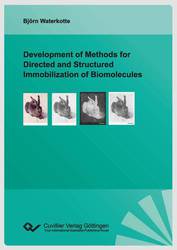| Areas | |
|---|---|
| Serie de libros (96) |
1378
|
| Nachhaltigkeit |
3
|
| Gesundheitswesen |
1
|
| Letra |
2365
|
| Ciencias Naturales |
5406
|
| Matemática | 229 |
| Informática | 319 |
| Física | 980 |
| Química | 1363 |
| Geociencias | 131 |
| Medicina humana | 243 |
| Estomatología | 10 |
| Veterinaria | 108 |
| Farmacia | 147 |
| Biología | 835 |
| Bioquímica, biología molecular, tecnología genética | 121 |
| Biofísica | 25 |
| Nutrición | 45 |
| Agricultura | 1004 |
| Silvicultura | 201 |
| Horticultura | 20 |
| Ecología y conservación de la tierra | 148 |
| Ciencias Ingeniería |
1793
|
| General |
98
|
|
Leitlinien Unfallchirurgie
5. Auflage bestellen |
|
Erweiterte Suche
Development of Methods for Directed and Structured Immobilization of Biomolecules (Tienda española)
Björn Waterkotte (Autor)Previo
Lectura de prueba, PDF (970 KB)
Indice, PDF (52 KB)
Surface immobilized molecules play a crucial role in applied as well as in basic research. They can be found in DNA or protein-array as well as in cell-migration or biochemical interaction experiments. Especially for proteins the immobilization can critically affect molecule accessibility and activity. In this work two essential aspects of protein immobilization were investigated: the identification of suitable surface functionalization by two array approaches and the generation of laterally structured gray scale protein patterns by projection lithography.
In proof-of-concept experiments a new strategy to create an array of different, neighboring functionalizations on the same surface was successfully tested. In “mechanical protection” inert plungers were applied to protect distinct surface areas from the surface functionalization reagents and allowed a selective modification of individual regions in serial reactions. In a particle based alternative approach a high spot density surface array was fabricated using functionalized, polyvinyl acetate, melamine and silicon oxide-based particles. The in situ encoded bead-based array (IEBA) allowed the study of immobilization conditions and the effect of protein adhesion. For the reliable and fast analysis of array-images with several thousand individual particles a custom open-source evaluation software was developed.
To create protein patterns a custom-built projection lithography device was utilized to generate high definition protein patterns. Patterning conditions were optimized with respect to deposition speed and signal to noise ratio while retaining a biocompatible process flow. The established technology provides protein patterns with great control over the deposited surface density, patterns were transferred within seconds to minutes to functionalized glass slides. To obtain three-dimensional, surface-functionalized surfaces this approach was transferred to thin polymer films. The substrates were demonstrated to be biocompatible with mouse fibroblasts. These surfaces allow a novel level of control addressing both the chemical surrounding and the shape of a cell microenvironment.
| ISBN-13 (Impresion) | 9783954045327 |
| ISBN-13 (E-Book) | 9783736945326 |
| Formato | A5 |
| Idioma | Inglés |
| Numero de paginas | 252 |
| Laminacion de la cubierta | mate |
| Edicion | 1. Aufl. |
| Lugar de publicacion | Göttingen |
| Lugar de la disertacion | Karlsruhe |
| Fecha de publicacion | 07.11.2013 |
| Clasificacion simple | Tesis doctoral |
| Area |
Química
Biología |
| Palabras claves | functional coatings, microstructures, photochemistry, surface modification, patterning, lithography, photolithography, biomedical applications, surface patterning, surface micropatterning, thin films, epitope screening, immobilization, immobilisation, surface chemistry, microarray, microthermoforming, thermoforming, photobleaching, protein patterning, fluorescence imaging, life sciences, chemistry, surface chemistry, surface chemistry array, protein adsorption patterning, FIJI, imaging, imageJ, image analysis, automated image analysis |








